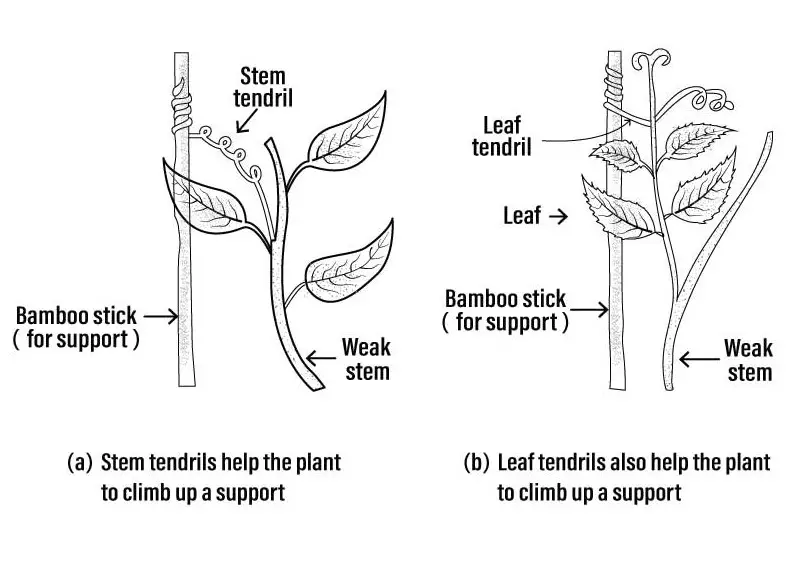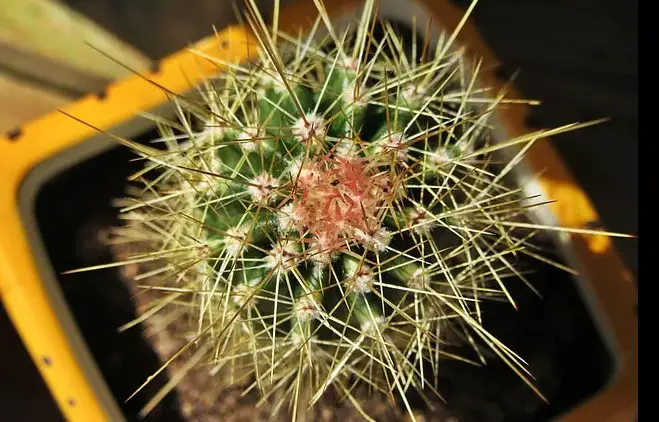Plants have evolved a fascinating array of adaptations to thrive in various environments, two notable examples being tendrils and spines. These features, while often confused due to their appearance, serve distinct roles in plant survival and success. Their development over millennia underscores the complexity of plant life and its ability to adapt to different ecological niches.
Tendrils are slender, thread-like structures that enable climbing plants to grasp and support themselves as they grow towards light sources. Spines, on the other hand, are sharp, hard structures that serve as a defense mechanism against herbivores. While tendrils are primarily found in climbing plants like grapes and peas, spines are characteristic of plants such as cacti, which thrive in arid environments.
The distinction between tendrils and spines lies in their function and form. Tendrils support the plant’s growth and help in maximizing light absorption for photosynthesis by anchoring to surfaces. Spines protect the plant from predators and minimize water loss by reducing the surface area exposed to hot, dry conditions. This differentiation not only highlights the diversity of plant adaptations but also emphasizes the intricate relationship between plants and their habitats.

Plant Adaptations
Plants have developed a wide array of adaptations to survive and thrive in diverse environments. These adaptations are not just about surviving in the short term but ensuring long-term growth, reproduction, and success in their habitats. From the depths of the rainforest to the arid deserts, plants exhibit remarkable strategies to meet their needs.
Survival Strategies
Plants employ various survival strategies to overcome environmental challenges. These include physical adaptations, such as the development of thorns, spines, and tendrils, and behavioral changes, like altering flowering times to avoid pollinator competition. Water conservation techniques, such as closing stomata or developing extensive root systems, are vital for plants in dry areas. In contrast, plants in waterlogged environments may develop aerenchyma to facilitate oxygen flow.
Adaptation Significance
The significance of these adaptations cannot be overstated. They allow plants to not only survive but to establish, compete, and reproduce in their respective ecosystems. These evolutionary adjustments contribute to the biodiversity and resilience of ecosystems, impacting everything from soil health to wildlife populations.
Tendrils Explained
Definition
Tendrils are slender, spiral structures that serve as a climbing aid for plants, allowing them to reach towards light by attaching to surfaces or other plants. They are a prime example of how plants adapt structurally to their environment.
Formation and Function
Tendrils form from various plant parts, including stems, leaves, or even inflorescences. Their primary function is to support climbing plants by attaching to surfaces, which enables these plants to grow towards light sources efficiently. This adaptation is crucial for plants in dense areas where light is scarce at ground level.
Types of Tendrils
- Stem tendrils: Emerge from the stem and are common in grapes.
- Leaf tendrils: Form from the leaf or parts of it, seen in peas.
- Inflorescence tendrils: Develop from flower parts, less common but present in some species.
Examples in Nature
- Grapevines (Vitis spp.) use stem tendrils to climb.
- Sweet peas (Lathyrus odoratus) have leaf tendrils that grasp supporting structures.
Spines Explained
Definition
Spines are sharp, rigid structures that protect the plant from herbivores. Unlike thorns, which are modified stems, and prickles, which are extensions of the skin, spines are usually modified leaves or parts of leaves.
Formation and Function
Spines develop to minimize water loss and protect the plant from herbivores. In arid environments, where water is scarce, spines can also reduce air flow around the plant, decreasing water evaporation. Their formation is a key survival adaptation for plants in hostile environments.
Types of Spines
- Leaf spines: Modified leaves that conserve water, such as in cacti.
- Stem spines: Hardened parts of the stem or branches.
Examples in Nature
- Cacti (Cactaceae) often have leaf spines that also help in water conservation.
- Acacia trees have stem spines that protect them from grazing animals.
Key Differences
Physical Structure
Tendrils are flexible and capable of coiling around objects for support, whereas spines are rigid and serve a protective function. The physical appearance and structure of tendrils and spines highlight the diverse strategies plants employ for survival and reproduction.
Biological Function
The primary function of tendrils is to support the plant in climbing towards light, which is crucial for photosynthesis. Spines, on the other hand, act as a defense mechanism against herbivores, protecting the plant from being eaten and ensuring its survival in the ecosystem.
Examples and Context
- Pea plants (Pisum sativum) utilize tendrils to secure themselves to supports and climb, optimizing light absorption for photosynthesis.
- Cactus plants rely on spines for defense against herbivores and to minimize water loss in hot, arid climates.
Role in Plant Survival
Plants have developed unique structures like tendrils and spines, not just as a whimsical trait but as essential tools for survival. These features allow plants to adapt to their environments in ways that enhance their chances of thriving.
Tendrils: Support and Climbing
Tendrils offer climbing plants the ability to reach towards the light in crowded or shaded environments where direct sunlight is a rare commodity. This characteristic is vital for photosynthesis, the process by which plants convert light into energy. By securing themselves to taller structures or other plants, they avoid being overshadowed by competitors.
Spines: Protection and Water Conservation
Spines serve a dual purpose: they are an effective defense mechanism against herbivores and a means of water conservation. Their sharpness deters animals from feeding on them, while their design minimizes the plant’s surface area exposed to the sun, reducing water loss through evaporation.
Environmental Impact
The presence of tendrils and spines on plants has a significant impact on their environment, influencing not just the plant’s survival but also the ecosystem’s balance.
Tendils: Climbing Mechanism
The climbing mechanism of tendrils can lead to an increase in plant biodiversity in dense forested areas by allowing different species to coexist. Climbing plants can grow upwards, utilizing vertical space, and in doing so, they bring about variations in habitat structures, offering niches for various organisms.
Spines: Defense and Adaptation
Spines are an evolutionary response to herbivory and harsh environmental conditions, such as high temperatures and water scarcity. Their presence can affect local fauna, discouraging certain animals from feeding on them and thus influencing the diet and behavior of herbivores. Additionally, spines can aid in the plant’s adaptation to fire-prone environments by protecting vital parts of the plant from heat damage.
Human Interaction
Human interaction with plants possessing tendrils and spines is multifaceted, encompassing areas such as gardening, agriculture, and landscape management. These interactions highlight the importance of understanding plant adaptations for practical applications.
Gardening and Agriculture
In gardening and agriculture, tendrils and spines are seen as beneficial traits for certain crops. Tendrils, for instance, are valued in the cultivation of climbing plants like peas and cucumbers, as they require less manual support to grow effectively. On the other hand, spines can be a challenge, especially in fruits like prickly pears, where they need to be removed before consumption. However, they also serve as a natural deterrent against pests, reducing the need for chemical pesticides.
Landscaping Benefits
Landscaping with plants that have tendrils or spines can add both aesthetic and functional value to a garden. Tendril-bearing vines can be used to create green walls and privacy screens, offering a natural way to beautify spaces. Spiny plants, such as certain cacti and succulents, can serve as low-maintenance options in dry climates, contributing to water conservation efforts and creating visually striking arrangements.
Ecological Considerations
Understanding the role of tendrils and spines in plant ecology is crucial for conservation efforts. These adaptations not only support the survival of individual plant species but also contribute to the overall health of ecosystems. Tendril-using climbers, for example, can support a higher density of life by providing habitats and food sources for insects and birds. Similarly, spiny plants can contribute to the resilience of ecosystems, especially in arid and semi-arid regions, by sustaining biodiversity and preventing soil erosion.
FAQs
What are plant tendrils?
Plant tendrils are thin, spiral structures that help climbing plants to attach and support themselves on surrounding structures. These flexible appendages grow rapidly, responding to touch stimuli by curling around objects, thereby aiding the plant in reaching sunlight without investing energy in sturdy stem structures.
How do spines protect plants?
Spines protect plants by deterring animals from eating them. These sharp, often pointed structures can cause physical harm to herbivores, making the plant less appealing as a food source. Additionally, spines can reflect sunlight, reducing leaf temperature and water loss, crucial in hot, arid habitats.
Can tendrils and spines be found on the same plant?
While tendrils and spines serve different functions, it’s rare but not impossible for a plant to have both. Some plants may develop spines as a defense mechanism and tendrils for support and climbing. However, this combination is uncommon as it reflects a significant adaptation to highly specific environmental conditions.
Why are tendrils important for climbing plants?
Tendrils are crucial for climbing plants because they allow these plants to attach to external supports and grow towards light sources without investing significant resources into developing strong, rigid stems. This adaptation enables them to thrive in dense vegetation by reaching light more efficiently and competing successfully.
Conclusion
The intricate designs of nature are nowhere more evident than in the contrasting functions of tendrils and spines in plants. These adaptations showcase the evolutionary ingenuity of flora to not only survive but flourish across diverse ecosystems. Tendrils facilitate growth and exploration, while spines offer protection and resilience, each playing a pivotal role in the survival strategy of their respective plant species.
Understanding these differences enriches our appreciation for the complexity of plant life and its adaptation strategies. It also underscores the importance of biodiversity and the need to protect natural habitats that nurture such diverse plant life. As we continue to explore and learn from the natural world, the lessons gleaned from tendrils and spines can inspire solutions for sustainability and conservation in our ever-changing environment.

